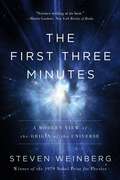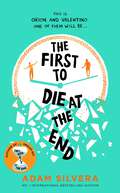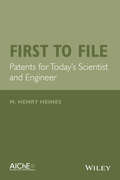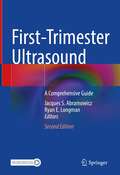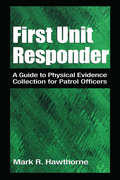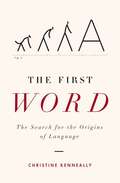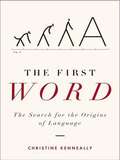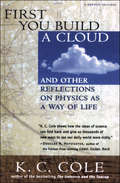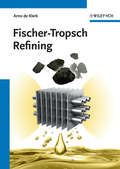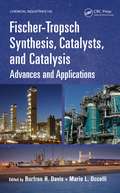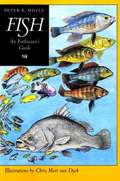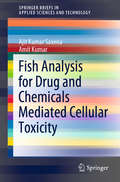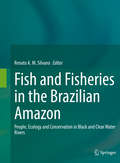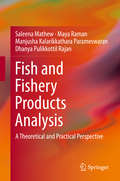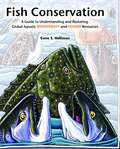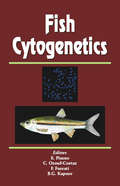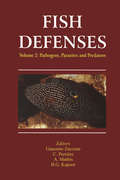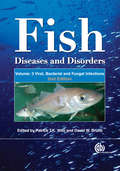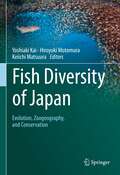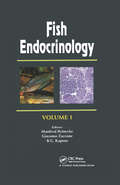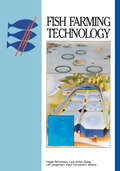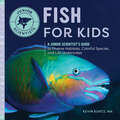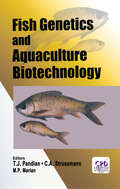- Table View
- List View
The First Three Minutes: A Modern View Of The Origin Of The Universe
by Steven WeinbergA Nobel Prize-winning physicist explains what happened at the very beginning of the universe, and how we know, in this popular science classic. Our universe has been growing for nearly 14 billion years. But almost everything about it, from the elements that forged stars, planets, and lifeforms, to the fundamental forces of physics, can be traced back to what happened in just the first three minutes of its existence.In this book, Nobel Laureate Steven Weinberg describes in wonderful detail what happened in these first three minutes. It is an exhilarating journey that begins with the Planck Epoch - the earliest period of time in the history of the universe - and goes through Einstein's Theory of Relativity, the Hubble Red Shift, and the detection of the Cosmic Microwave Background. These incredible discoveries all form the foundation for what we now understand as the "standard model" of the origin of the universe. The First Three Minutes examines not only what this model looks like, but also tells the exciting story of the bold thinkers who put it together. Clearly and accessibly written, The First Three Minutes is a modern-day classic, an unsurpassed explanation of where it is that everything really comes from.
The First to Die at the End: The prequel to the international No. 1 bestseller THEY BOTH DIE AT THE END!
by Adam SilveraIn this prequel to the NO. 1 INTERNATIONAL BESTSELLING phenomenon of TIKTOK fame, They Both Die at the End, two new strangers spend a life-changing day together after Death-Cast make their first fateful calls. '[A] heart-pounding story [full] of emotion and suspense.' Kirkus 'An extraordinary book with a riveting plot.' BooklistMeet Orion and Valentino. It&’s the night before Death-Cast goes live, and there&’s one question on everyone&’s mind: Can Death-Cast actually predict death, or is it an elaborate hoax? Orion Pagan has waited years for someone to tell him that he&’s going to die, given his serious heart condition. Valentino Prince has a long and promising future ahead of him and only registered for Death-Cast after his twin sister nearly died in a car accident. Orion and Valentino cross paths in Times Square and immediately feel a deep connection. But when the first End Day calls go out, their lives are changed for ever – one of them receives a call . . . the other doesn&’t. Told with acclaimed author Adam Silvera&’s signature bittersweet touch, this story celebrates the lasting impact that people have on each other and proves that life is always worth living to the fullest. PRAISE FOR ADAM SILVERA: 'There isn't a teenager alive who won't find their heart described perfectly on these pages.' Patrick Ness, author of The Knife of Never Letting Go 'Adam Silvera is a master at capturing the infinite small heartbreaks of love and loss and grief.' Nicola Yoon, author of Everything, Everything 'A phenomenal talent.' Juno Dawson, author of Clean and Wonderland 'Bold and haunting.' Lauren Oliver, author of Delirium
First to File: Patents for Today's Scientist and Engineer
by M. Henry HeinesBridges the gap between the realistic needs and questions of scientists and engineers and the legal skills of professionals in the patent field at a level accessible to those with no legal training * Written for inventors in lay terms that they can relate to or easily follow * Lays out the new features of patent law introduced by the America Invents Act of 2012 * Explains the differences between the first-to-invent and first-to-file rules and why the two rules will coexist * Focuses on the growth of new technologies in industry versus the laws protecting them
First-Trimester Ultrasound: A Comprehensive Guide
by Jacques S. Abramowicz Ryan E. LongmanThis second edition offers a unique and focused study of the use of ultrasound during the first trimester, a critical time in a fetus’ development. It includes basic examination guidelines as well as cutting-edge ultrasound modalities, including Doppler and three-dimensional ultrasound, for the period immediately preceding conception through early embryology. Fully updated, the text begins with a discussion of the safety and efficacy of diagnostic ultrasound and the use of this modality for the evaluation and treatment of infertility. Recognized experts in the field then explore conditions that may interfere with normal conception or development, including maternal diseases that would benefit from early scanning, elements of teratology, multiple gestations, ectopic pregnancy, gestational trophoblastic disease, fetal anomalies and invasive procedures in the first trimester. This edition includes seven new chapters focusing on the imaging of fetal development, including chapters on the first trimester fetal brain, genitourinary tract, and diagnosis of fetal genetic syndromes. Numerous illustrations, figures, and online videos serve as aides for understanding key concepts. First-Trimester Ultrasound, 2e is a valuable resource for many, in or after training, in obstetrics and gynecology, radiology, emergency medicine, family medicine and genetics.
First Unit Responder: A Guide to Physical Evidence Collection for Patrol Officers
by Mark R. HawthorneFirst Unit Responder: A Guide to Physical Evidence Collection for Patrol Officers is a training guide and reference for patrol officers and criminal investigators, who conduct preliminary investigations of crime scenes, to aid in identification, collection, and booking of physical evidence. Written by a veteran of 24 years of law enforcement, the book stresses the importance of understanding the critical nature of physical evidence and preservation of the crime scene as part of the case against a criminal defendant. This book is an important tool for police academies that train recruits and veteran patrol officers, as well as for students of criminal justice who seek guidelines for proper collection and handling of physical evidence.
The First Woman Doctor
by Rachel BakerIn 1847, there were no women doctors. Elizabeth Blackwell was however, determined to become the first woman doctor, no matter what everyone else told her.
The First Word: The Search for the Origins of Language
by Christine KenneallyThis is about the quest for the origins of human language, in two sections. The first explains how language developed and the processes of evolution. The second tells why scientists are at last able to explore the subject.
The First Word
by Christine KenneallyAn accessible exploration of a burgeoning new field: the incredible evolution of language The first popular book to recount the exciting, very recent developments in tracing the origins of language, The First Word is at the forefront of a controversial, compelling new field. Acclaimed science writer Christine Kenneally explains how a relatively small group of scientists that include Noam Chomsky and Steven Pinker assembled the astounding narrative of how the fundamental process of evolution produced a linguistic ape?in other words, us. Infused with the wonder of discovery, this vital and engrossing book offers us all a better understanding of the story of humankind. .
First You Build a Cloud: And Other Reflections on Physics as a Way of Life
by K. C. ColeThis clearly written and compelling look at physics and physicists offers &“thousands of new ways to see our daily world more richly&” (Douglas Hofstadter, author of Gödel, Escher, Bach). For many of us, physics has always been a thing of mystery and complexity. K. C. Cole, an award-winning science writer, specializes in making its wonders accessible to the everyday reader. This book uses lively prose, metaphors, and anecdotes to allow us to comprehend the nuances of physics: gravity and light, color and shape, quarks and quasars, particles and stars, force and strength. It also shows us how the physical world is so deeply intertwined with the ways we think about culture, poetry, and philosophy, and explores the workings of such legendary scientific minds as Richard Feynman, Victor Weisskopf, brothers Frank Oppenheimer and J. Robert Oppenheimer, Philip Morrison, Vera Kistiakowsky, and Stephen Jay Gould. &“An exemplary science writer . . . For readers without scientific background, Cole gracefully introduces relativity, quantum theory, optics, astrophysics, and other significant disciplines, never getting bogged down in unnecessary explanation. Thus, you may not learn all about thermodynamics from reading her chapter on it, but you will learn enough to think seriously about the entropy in your own life. Cole sprinkles her text with comments from famous scientists—&‘Space is blue, and birds fly in it,&’ said Heisenberg, and Faraday said, &‘Nothing is too wonderful to be true&’—that are not only delightful in themselves but perfectly suited to her own text. No review of Cole&’s book could be too wonderful to be true.&” —Booklist
Fischer-Tropsch Refining: Coal-to-liquids Production And Refining (Catalysis Ser. #4)
by Arno De KlerkThe Fischer-Tropsch process is gaining recognition again due to the world-wide increase in energy needs and decrease in oil availability. The increasing interest in utilizing biomass as a potential renewable feedstock in energy generation is further supporting this development. The book covers the production and refining of Fischer-Tropsch syncrude to fuels and chemicals systematically and comprehensively, presenting a wealth of new knowledge and material. As such, it deals extensively with aspects of engineering, chemistry and catalysis. This handbook and ready reference adopts a fundamental approach, looking at the molecules and their transformation from feed to product. Numerous examples illustrate the possibilities and limitations of Fischer-Tropsch syncrude as feesdstock. Of great interest to everyone interested in refining - not just Fischer-Tropsch specialists. From the Contents: Fischer-Tropsch Facilities and Refineries at a Glance Production of Fischer-Tropsch Syncrude Industrial Fischer-Tropsch Facilities Synthetic Transportation Fuels Refining Technology Refinery Design
Fischer-Tropsch Synthesis, Catalysts, and Catalysis: Advances and Applications (Chemical Industries Ser. #Vol. 142)
by Burtron H. Davis Mario L. OccelliWith petroleum prices spiraling upward, making synthetic fuels-or "synfuels"-from coal, natural gas, and biomass has become more economically competitive. Advanced energy companies now focus exclusively on alternative fuels, and many oil companies have programs dedicated to developing synthetic fuels. The Fischer-Tropsch process, which uses a colle
Fish: An Enthusiast's Guide
by Peter B. MoyleEngagingly written, with both learning and humor, Fish bridges the gap between purely pictorial books and scholarly texts, and provides a succinct summary of fish biology and conservation for students and fish enthusiasts.
Fish Analysis for Drug and Chemicals Mediated Cellular Toxicity (SpringerBriefs in Applied Sciences and Technology)
by Ajit Kumar Saxena Amit KumarThis book offers a comprehensive overview of drug and chemical cellular toxicity, especially concerning the effects of anticancer drugs (cyclophosphamide, methotrexate and phosphamidon) on chromosomes and proteins. It covers histological changes in rat testis during pre- and postnatal exposure to varied drug doses, along with laboratory findings on arsenic exposure and alcohol consumption producing neurological changes and deleterious effects on reproductive health in animals. The book offers essential information on the role of anticancer drug- / chemical-mediated toxicity in connection with genetic changes in the brain and reproductive health, making it a valuable guide for researchers working in the areas of cancer research, infertility, molecular diagnostics and modern drug discovery, at biochemical and toxicity laboratories, and in genetic predisposition and molecular biology in general.
Fish and Fisheries in the Brazilian Amazon: People, Ecology and Conservation in Black and Clear Water Rivers
by Renato A. M. SilvanoThis book provides comparative data on fish ecology and small-scale fisheries between Tapajos (clear water) and Negro (black water) rivers, in the Brazilian Amazon. These rivers are less studied than white water rivers and few books on Amazon fishes have addressed more than one river basin. These data can serve as a baseline to check future changes or impacts in these rivers, which can be affected by development projects, such as highways, deforestation, mining and dams. Besides information on fish biology, the book also discusses fish uses, fisheries and its importance for riverine people, comparing these data for each fish species between sites located inside and outside conservation units. The book is an outcome of the research project ‘Linking sustainability of small-scale fisheries, fishers’ knowledge, conservation and co-management of biodiversity in large rivers of the Brazilian Amazon’, which was coordinated by the editor of this volume and funded by United States Agency for International Development (USAID) and National Academies of Science, Engineering and Medicine (NAS).
Fish and Fishery Products Analysis: A Theoretical and Practical Perspective
by Saleena Mathew Maya Raman Manjusha Kalarikkathara Parameswaran Dhanya Pulikkottil RajanThis novel and informative book discusses the various aspects of seafood quality. The book is divided into 7 broad sections, each tackling a different aspect. The first section covers the general aspects relevant to the nutritional quality of the fish and the various extraction protocols for macro-/ micro-nutrients. The second section provides insights into handling and the principles of thermal and non-thermal processing techniques for commercially important fishery products. The quality standards and safety concerns in the seafood industry and consumption are discussed in this section. The freshness indices of the processed products including biochemical, microbiological and toxicological characteristics are also included. The third section discusses the physico-chemical characteristics and quality parameters of potable water/ ice. The fourth section includes the quality assessment of various toxicants related to seafood products. The fifth section deals with the specific aspects such as principle, instrument and procedures of conventional and novel analytical instruments relevant to the seafood industry. The sixth section deals with the seafood waste management including solid and liquid seafood wastes. Presently, there is a great awareness regarding environmental sustainable processing/ preservation techniques. The final chapter discusses the bioactive compounds from under-utilized marine sources showing pharmaceutical/ nutraceutical applications.
Fish Conservation: A Guide to Understanding and Restoring Global Aquatic Biodiversity and Fishery Resources
by Gene S. HelfmanFish Conservation offers, for the first time in a single volume, a readable reference with a global approach to marine and freshwater fish diversity and fishery resource issues. Gene Helfman brings together available knowledge on the decline and restoration of freshwater and marine fishes, providing ecologically sound answers to biodiversity declines as well as to fishery management problems at the subsistence, recreational, and commercial levels. Written in an engaging and accessible style, the book:considers the value of preserving aquatic biodiversityoffers an overview of imperiled fishes on a taxonomic and geographic basispresents a synthesis of common characteristics of imperiled fishes and their habitatsdetails anthropogenic causes of declineexamines human exploitation issuesaddresses ethical questions surrounding exploitation of fishesThe final chapter integrates topics and evaluates prospects for arresting declines, emphasizing the application of evolutionary and ecological principles in light of projected trends. Throughout, Helfman provides examples, explores case studies, and synthesizes available information from a broad taxonomic, habitat, and geographic range.Fish Conservation summarizes the current state of knowledge about the degradation and restoration of diversity among fishes and the productivity of fishery resources, pointing out areas where progress has been made and where more needs to be done. Solutions focus on the application of ecological knowledge to solving practical problems, recognizing that effective biodiversity conservation depends on meeting human needs through management that focuses on long term sustainability and an ecosystem perspective.
Fish Cytogenetics
by E. PisanoIn the past 20 years, fish cytogenetics has become an essential tool in fields as diverse as systematics and evolution, conservation, aquaculture and more recently, genomics. This book is organized in four sections (systematics and evolution; biodiversity conservation; stock assessment and aquaculture; genomics) covering the major fields of present
Fish Defenses Vol. 2: Pathogens, Parasites and Predators
by Giacomo ZacconeDramatic changes in the environment, including habitat degradation and climate change, have focused attention on how individuals and populations respond to a shifting biotic and abiotic landscape. A critical step toward meeting this goal is a clear understanding of the capacity of individuals to defend themselves against threats. Changes in water q
Fish Diseases and Disorders, Volume 3: Viral, Bacterial and Fungal Infections (2nd edition)
by Patrick T. K. Woo David W. BrunoThis third and final volume in the acclaimed Fish Diseases and Disorders trilogy addresses infectious diseases of finfish and shellfish caused by viruses, bacteria and fungi. Topics covered include infectious pancreatic necrosis virus, infectious hematopoiectic necrosis virus, viral diseases of cold- and warm-water fish, rickettsial and chlamydial infections, furunculosis, motile aeromonads, vibriosis, flavobacterial diseases and shellfish diseases. Written by experts in each discipline and updated throughout to reflect new developments in the field, including new chapters on alphaviruses, oncogenic viruses and genomics and proteomics, this is a must-have reference for fish health specialists and veterinarians, microbiologists, zoologists and researchers, and students in aquaculture.
Fish Distant Hybridization
by Shaojun LiuThe book introduces fish distant hybridization, which covers the basic theory and applications of fish distant hybridization as well as the main biological characteristics of different ploidy fish at the individual, tissue, cell, and molecular level. It is divided into 12 Chapters. The research progresses of animal distant hybridization and polyploids in domestic and overseas are summarized in this book. The characteristics of these hybrids and polyploid fish are also illustrated on basis of considering factors of the chromosomes numbers, phylogenetic relationship, reproduction, appearance, feeding habits, growth rate, and stress resistance. The creation of fish distant hybridization lineages will provide a clear genetic background which is helpful for the study of the strain generation as a model in genetic variation characteristics and reproductive characteristics. Fully illustrated in color, this book provides unique ideas in system description and presentation of distant hybridization and polyploidy fish. In fish genetic breeding, the tetraploid fish lineage and diploid fish lineage, formed through distant hybridization, can be used for preparing large-scale triploid and diploid fish. This book is a useful reference for researchers in fish genetic breeding, aquaculture, developmental biology, and animal evolution, and serves as a valuable resource for students and researchers engaging in zoology, evolutionary biology, and genetics.
Fish Diversity of Japan: Evolution, Zoogeography, and Conservation
by Yoshiaki Kai Hiroyuki Motomura Keiichi MatsuuraThis book reviews and summarizes the studies on the fish diversity of Japan. It covers the present knowledge of ichthyofauna, habitat distribution, phylogeography, ecology, morphology, and conservation, as well as the history of ichthyology and fish collections in Japan. The book comprises five parts: I. Fish Diversity and Ichthyology of Japan, II. Habitat Distribution and Species Diversity, III. Diversity within Species: Phylogeographic Perspective on Japanese Fishes, IV. Morphological and Ecological Diversifications, and V. Conservation of Fish Diversity in Japan. The Japanese Archipelago is surrounded by two major warm and one cold currents. It is located in the western North Pacific and encompasses several climatic regimes from north to south. Although the land area of Japan is small, the Exclusive Economic Zone (EEZ) of Japan ranks as the sixth largest in the world, including several marginal seas (Sea of Okhotsk, Sea of Japan, and East China Sea), and deep trenches (Izu-Ogasawara, Japan, and Kurile Trenches). Owing to a variety of marine habitats and a complex geological history, Japan has a rich fish species diversity, representing over 4,500 species in 370 families. The richness of fish species diversity has attracted many scientists since the late 1700s, and continuous studies have led to the development of ichthyology in Japan. With chapters written by leading experts in the field, the book will provide a stimulating and reliable resource for future research and contribute to the progress of ichthyology of the world.
Fish Endocrinology (2 Vols.)
by Giacomo Zaccone B. G. Kapoor Manfred ReineckeDuring the past two decades, fish endocrinology has witnessed exciting developments due to our increased knowledge at all levels of biological organizations, including molecular biology, cell biology, physiology and behavior. New insights into development, neurobiology, immunology and molecular genetics closely correlated with classical aspects of
Fish Farming Technology
by H. Reinersten L.A, Dahle L. JorgensenOver the past few years, it has become more and more obvious that fish farming will become increasingly important in the future. As fish farming moves into its industrial phase, technology will be an important factor in determining its successful development. It is therefore important for scientists & representatives from the aquaculture industry to meet to define state of the art and explore future development of fish farming technology for different fish species. 81 papers and abstracts were presented at the conference. The proceedings reflect the different sections of the conference: the plenum sessions and three parallel sessions: Juvenile marine fish, open production plants, closed production plants and poster sessions.
Fish for Kids: A Junior Scientist's Guide to Diverse Habitats, Colorful Species, and Life Underwater (Junior Scientists)
by Kevin Kurtz MASplash into the incredible world of fish with the Junior Scientists series for kids ages 6 to 9 Get up close and personal with the fascinating fish that live all around the world. Fish for Kids is full of colorful photos and illustrations that help you explore 35 different species, from goldfish and neon tetras to eels and great white sharks! Interactive learning—Unlike other fish books for kids, this one features hands-on activities and tips for going fishing or keeping your own aquarium. Fun facts—Learn how fish use camouflage, how they find food, and which fish can swim almost 70 miles per hour! Fishy profiles—Go beyond other fish books for kids with complete profiles on freshwater and saltwater fish, including where they live, how big they get, and more. Take a peek into the lives of fish in this standout choice among fish books for kids.
Fish Genetics and Aquaculture Biotechnology
by T. J. Pandian C. A. Strüssmann M. P. MarianTo feed the growing world population, water is looked upon as a major source of food production. This book is an attempt to bring out a comprehensive volume on Fish Transgenesis, Chromosome Engineering and Sex Control, Molecular Endocrinology, Microbal Diseases and Vaccines, and Bioactive Compounds.
